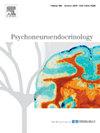Associations of neighborhood contexts and family-level hair cortisol concentration within Mexican immigrant families
IF 3.4
2区 医学
Q2 ENDOCRINOLOGY & METABOLISM
引用次数: 0
Abstract
Many Mexican American immigrant families live in socioeconomically disadvantaged neighborhoods, which are recognized as risk factors influencing residents’ stress. However, how neighborhood contexts can impact physiological stress at the family level, as indicated by hair cortisol concentration (HCC), particularly among Mexican immigrant family members remains unclear. Using a person-centered approach, the current study identified distinct patterns of family-level HCC and examined their associations with neighborhood contexts (i.e., Hispanic/immigrant concentration, socioeconomic disadvantage, affluence). Participants included 398 adolescents (56.5 % female, Mage = 13.26) and their mothers and fathers. Two profiles emerged and suggested that families living in neighborhoods with higher Hispanic/immigrant concentration and lower affluence were more likely to be in the high family-level HCC group compared to the low family-level HCC group. No group differences were found for neighborhood socioeconomic disadvantage. These results highlight the importance of including multiple family members (child and parents) to provide a more comprehensive understanding of how biological stress crossover within families. Our findings also emphasize the importance of integrating neighborhood contexts in shaping the physiological stress levels of Mexican American immigrant families.
墨西哥移民家庭中社区背景和家庭水平毛发皮质醇浓度的关联
许多墨西哥裔美国移民家庭生活在社会经济条件较差的社区,这是公认的影响居民压力的危险因素。然而,社区环境如何影响家庭水平的生理应激,如头发皮质醇浓度(HCC)所表明的,特别是在墨西哥移民家庭成员中仍不清楚。采用以人为中心的方法,目前的研究确定了家庭水平HCC的不同模式,并检查了它们与社区背景(即西班牙裔/移民集中、社会经济劣势、富裕程度)的关系。参与者包括398名青少年(56.5 %女性,法师= 13.26)及其父母。出现了两份资料,表明居住在西班牙裔/移民集中度较高且富裕程度较低的社区的家庭更有可能成为高家庭水平HCC组,而不是低家庭水平HCC组。邻里社会经济劣势没有发现群体差异。这些结果强调了包括多个家庭成员(孩子和父母)的重要性,以便更全面地了解生物压力如何在家庭中交叉。我们的研究结果还强调了整合社区背景在塑造墨西哥裔美国移民家庭生理压力水平方面的重要性。
本文章由计算机程序翻译,如有差异,请以英文原文为准。
求助全文
约1分钟内获得全文
求助全文
来源期刊

Psychoneuroendocrinology
医学-精神病学
CiteScore
7.40
自引率
8.10%
发文量
268
审稿时长
66 days
期刊介绍:
Psychoneuroendocrinology publishes papers dealing with the interrelated disciplines of psychology, neurobiology, endocrinology, immunology, neurology, and psychiatry, with an emphasis on multidisciplinary studies aiming at integrating these disciplines in terms of either basic research or clinical implications. One of the main goals is to understand how a variety of psychobiological factors interact in the expression of the stress response as it relates to the development and/or maintenance of neuropsychiatric illnesses.
 求助内容:
求助内容: 应助结果提醒方式:
应助结果提醒方式:


